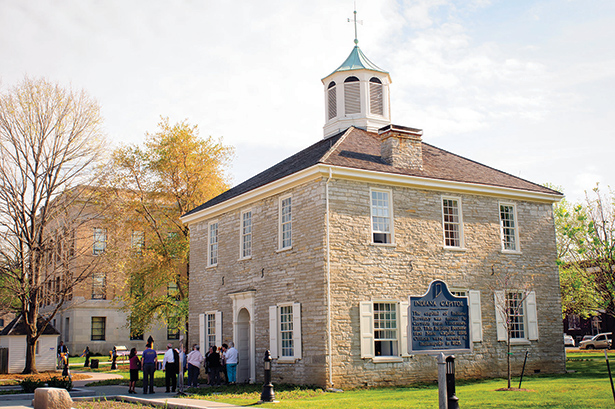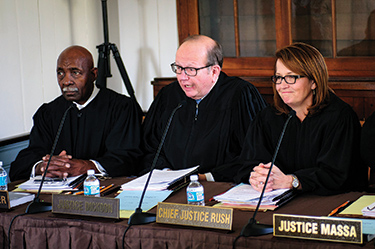
Indiana Supreme Court returns to original Courtroom in Corydon as part of 2016 Bicentennial Celebration
The Supreme Court is committed to providing an opportunity for students to learn about the courts even if they cannot attend oral argument at the State House. Since 1994 the Court has held more than forty traveling oral arguments. The arguments are part of an initiative to highlight the judicial process and provide lessons on the importance of upholding the law.
Indiana’s Bicentennial celebration offered the perfect opportunity for the Court to honor Indiana’s rich legal history with a unique oral argument on the road. In April, the Court celebrated the Bicentennial with a visit to the historic setting of the state’s first high court in Corydon. The Bicentennial Commission endorsed the program as a Legacy Project.
Judges, lawyers, school leaders, teachers and community members came together to celebrate the admission of Indiana into the union and honor the state’s solid foundation based on the rule of law. The Indiana State Bar Association’s Leadership Development Academy (LDA) supported the event—including providing onsite assistance with LDA members serving as ambassadors from the legal community to the public.
The original Supreme Court courtroom was a space of roughly five hundred square feet! The room housed the state’s first Supreme Court, which consisted of three judges. The original Senate chamber was across the hall and the House of Representatives downstairs. The building has not changed in 200 years—which presented unique challenges for hosting a modern day argument.
With limited seating, only about thirty people attended the argument to represent the three branches of government, state and local bar associations, students, teachers and members of the public. One newspaper reporter, Elizabeth DePompei of the News and Tribune, in Southern Indiana, was present and served as the pool reporter providing information to her colleagues across the state.
She said, “It was an honor to cover a day packed with so much history and celebration. For many, it was a way to acknowledge Corydon’s role in the Indiana Supreme Court’s long story. For others, it was a personal marker, including one attorney who argued before the Court for the first time in her career. For Indiana Supreme Court Justice Brent Dickson, it was the last time he would hear oral arguments. As a reporter, the only challenge was deciding which remarkable stories to tell.”

True to the 1816 setting, the courtroom lacked modern amenities such as lights, a sound system, or air conditioning. There was one major exception—a connection to a television satellite truck. Thanks to a partnership with Indiana Public Broadcasting Stations and the Indiana Department of Education the argument in the case of F. John Rogers, et al. v. Angela Martin, et al. was webcast live to classrooms across the state.
Indiana Superintendent of Public Instruction Glenda Ritz was in attendance and explained why the Department of Education supported the initiative. “It is important that students leave our K-12 education system with a strong sense of civic responsibility and an understanding of the relevance of laws and the Court to their lives. I am excited that the Department of Education was able to share a live-stream of the Oral Argument with schools across the state, but I’m even more excited that we will be able to share this amazing resource with students in classrooms across the state for years to come.”
Judges and lawyers volunteered to visit classrooms around the state and use the Corydon oral argument as an avenue to speak about the judicial process. These volunteers visited over two thousand students across Indiana.
- Clark County – Judge Brad Jacobs at Jeffersonville High School
- Clay County – Judge Blaine Akers at Northview High School
- Dearborn County – Judge Jonathan Cleary at East Central High School
- Fayette County – Judge Beth Butsch at Connersville High School
- Hamilton County – Holly Newell at New Britton Elementary School
- Harrison County – Judge Joseph Claypool at Lanesville High School
- Huntington County – Robert Eherenman at Huntington North High School
- Johnson County – Judge Marla Clark at Center Grove High School
- LaPorte County – Magistrate Nancy Gettinger at New Prairie Elementary School
- Marion County – Judge Martha Wentworth and Brandee Chanin at Lincoln Middle School
- Marion County – Brian Clouse at Spring Mill Elementary School
- Marion County – Mike Commons at IPS #59 – Merle Sidener Academy
- Marion County – Lisa Davidson at Warren Central High School
- Marion County – Amber Finley and Nicole Schuster at St. Joan of Arc
- Marion County – Jessica Gastineau at IPS Rousseau McClellan School 91
- Marion County – Michelle Goodman at Girl Scout Troop 623
- Marion County – Kyle Hunter at Harrison High School (Tippecanoe County)
- Marion County – Dino Pollock at Carpe Diem Northwest
- Marion County – Ashley Rozier at Northrup High School (Allen County)
- Miami County – Judge Tim Spahr at Peru High School
- Newton County – Judge Daniel Molter at South Newton Elementary
- Putnam County – Judge Matt Headley at North Putnam Middle School
- Warrick County – Judge Greg Granger at Boonville High School
- Wayne County – Judge Darrin Dolehanty at Centerville High School
- Wells County – Judge Kenton Kiracofe at St. Aloyius Catholic School (Allen County)
- Whitley County – Judge Douglas Fahl at Columbia City High School
To improve students’ understanding of the case and for judges visiting the classroom, the Office of Communication, Education and Outreach provided online resources emphasizing case details and associated documents—including the appellate briefs and Court of Appeals opinion.
In addition to schools, the webcast was available online for the public. It was shown live in the courtroom of the Harrison Circuit Court, which sits on the town square near the historic State Capitol building. Circuit Court Judge John Evans assisted with the logistics and welcomed the one hundred guests who were seated in his courtroom for the live webcast. Judge Evans noted, “Hosting a modern argument in a historic setting was certainly a challenge. But the entire event, including the webcast of the Court’s return to the first Supreme Court courtroom was a tremendous success!”
The Court partnered with the Indiana Archives and Records Administration (IARA) to make historic documents available for viewing at the celebration. State Archives Director Jim Corridan and IARA staff traveled to Corydon with the Supreme Court’s first Order Book and files from an 1820 case, State v. Lasselle—better-known now as the “Polly Strong case.”
Polly was a slave who won her freedom through the Supreme Court’s decision, and a historic marker was dedicated to her as part of the day’s celebration. Mr. Corridan reflected, “It was wonderful to be able to participate in the Supreme Court’s programming in Corydon. Rarely do the original early Court’s records go on public display, and there was no better opportunity during the Bicentennial than the Court’s hearing.”
With thirteen hundred officially endorsed Bicentennial Legacy Projects across the state, Bicentennial Commission Executive Director Perry Hammock noted the uniqueness of the Court’s program.
Hammock, who attended in person, explained, “What a wonderful way to tie the history of Indiana to its present and promise of the future. We were able to see that while the buildings and trappings of the Court have changed over generations, the issues and rulings they consider have the same lasting impact. The Justices returning to Corydon would have made the original court members proud, as it did for all of us in attendance.”